The Revelation of John was written around 95 AD. The author, who simply calls himself Brother John, is not identical with the Apostle John. According to his account, he is on the island of Patmos on the Lord's Day when God commands him to write down what he sees and send it to his seven congregations in Asia Minor. The heavenly visions he observes have many similarities with halo phenomena. The following aims to show that the observation of a halo phenomenon underlies the Revelation of John. Even in the epistolary introduction (Rev. 1:7) it says:
"Behold, he (meaning Jesus Christ) came with the clouds,..". Ice crystals that cause halo phenomena are mostly found in thin veil clouds. Only when such clouds cover the sky do halos also appear.
"Behold, he (meaning Jesus Christ) came with the clouds,..". Ice crystals that cause halo phenomena are mostly found in thin veil clouds. Only when such clouds cover the sky do halos also appear.
His vision begins with the following observation:
"Then I turned to see the voice that was speaking with me. And having turned, I saw seven golden lampstands, and in the middle of the lampstands one like a son of man, clothed in a robe reaching to the feet, and girded across His chest with a golden sash. His head and His hair were white like white wool, like snow; and His eyes were like a flame of fire. His feet were like burnished bronze, when it has been made to glow in a furnace, and His voice was like the sound of many waters. In His right hand, He held seven stars, and out of His mouth came a sharp, two-edged sword; and His appearance was like the sun shining in its full strength."
"Then I turned to see the voice that was speaking with me. And having turned, I saw seven golden lampstands, and in the middle of the lampstands one like a son of man, clothed in a robe reaching to the feet, and girded across His chest with a golden sash. His head and His hair were white like white wool, like snow; and His eyes were like a flame of fire. His feet were like burnished bronze, when it has been made to glow in a furnace, and His voice was like the sound of many waters. In His right hand, He held seven stars, and out of His mouth came a sharp, two-edged sword; and His appearance was like the sun shining in its full strength."

The robe girded at the chest

The Feet That Glow Like Gold Ore
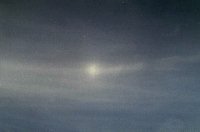
One of the chandeliers

The Double-Edged Sword
That its appearance resembled the sun is understandable: it was the sun itself that John saw. He did not recognize the sun because a multitude of geometric figures could be seen around it, unlike anything he had ever experienced. Regarding the robe reaching down to the feet and the head of the Son of Man, it is the 22° halo. His observation that the hair and his head were white like snow corresponds with the predominant color of the 22° halo. Often, hair-like fringes can be seen on the outer edge of the 22° halo, which are created by the fibrous structure of cirrus clouds.
As for the eyes that look like flames of fire, these are the 22° parhelia. Even today, sun dogs are often described by casual observers as flaming phenomena. The comparison with flames is quite fitting for sun dogs.
The belt around the chest is the horizontal circle, which apparently was only visible within the 22° halo. The horizontal circle then extends to the parhelia. In this case, John would have had the impression that the belt stretches across the face. His observation of the slightly lower belt can be explained by the fact that the horizontal circle was not developed to the parhelia but only extended about 15° to the right and left of the sun. In this case, the impression is that the horizontal circle runs around the chest.
The decisive question is the sun's height at the beginning of his visions. Many types of halos change significantly with the sun's height or cannot form at certain solar positions. A first clue is the observation that the person's feet resembled glowing brass. So, a further halo type was visible below the robe, which has the shape of feet. This is the lower tangent arc to the 22° halo. At a sun height of 25°, this halo type actually looks very similar to feet. The color of the lower tangent arc is white, which slightly shifts to a brownish-red color. This corresponds well with the color of glowing metal. Moreover, the lower tangent arc can become dazzlingly bright ("glowing"). It should be noted that the sun's height must have been at least 25° for the lower tangent arc below the 22° halo to be clearly visible. This sun height also corresponds well with the observation of the parhelia and the horizontal circle appearing like a belt.
However, this sun height fits less well with the two-edged sword, where only a light pillar can be considered as a halo phenomenon. Light pillars primarily occur at a low sun position, about 0-10°. Such a sun height would make the observation of a lower tangent arc impossible, as it would then still be below the horizon. It is conceivable, at most, that the halo phenomenon was seen in ice fog at the ground. However, according to John's accounts, he is on the island of Patmos, which lies too far south for the low temperatures (below -10°C) required for ice fog formation to occur even in winter. Therefore, it is likely the rare case of a light pillar at a sun position of 25°. Light pillars at this sun position are rare but not impossible. The SHB has several observations of light pillars at this sun position.
While John's previous descriptions of halos still quite closely matched the real appearance, it's more difficult to find a relationship to halos with the seven golden lampstands and the seven stars in his right hand. The golden lampstands could be the 120° parhelia. However, there are only two, not seven. The number seven should not necessarily be considered a real observation. His writing is addressed to the seven churches, and the seven lampstands represent his congregations. The numerical references in his letter are symbolic. The numbers seven and twenty-four repeatedly occur. The suggestion that the lampstands are the 120° parhelia is supported by the fact that he saw the lampstands when he turned around. The 120° parhelia are so far apart that they can only be seen by turning around, especially with a low sun position. Merely letting the eyes wander is not enough. On the other hand, the seven stars cannot be associated with halos.
"And behold, a throne stood in heaven, and One sat on the throne. And the one sitting was like a jasper stone and a carnelian, and above the throne was a rainbow that looked like an emerald..."And seven torches of fire were burning before the throne, which are the seven spirits of God. And before the throne was something like a sea of glass, like crystal."
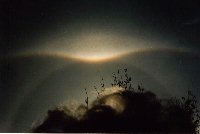
The Throne in Heaven
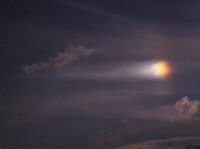
A torch
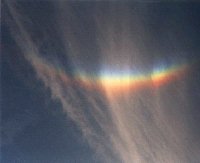
The Rainbow Over the Throne
Next, John perceives a throne in heaven. With a sun altitude of 15-35°, the shape of the upper tangent arc resembles a throne. In the middle, a seat depression and armrests at the sides. Thus, the throne is the upper tangent arc to the 22° halo. It is somewhat surprising that he did not describe the throne in the first image. After all, the lower tangent arc was visible. The upper tangent arc also forms in the same ice crystals. It is conceivable that the ice clouds, which mainly consist of column crystals, were still on the horizon in the first image, so that only the lower tangent arc was visible. Subsequently, these clouds moved closer and the upper tangent arc also formed. This process does not take a long time, so that the sun altitude was about 26°. John continues that someone sat on the throne, looking like jasper and carnelian. As a halo phenomenon lying directly on the upper tangent arc, only the Parry arc comes into consideration. The color of the Parry arc matches the color described by John. Carnelian is a mineral that is red and translucent. Jasper is a white, translucent stone that shines in the light. This matches the color of the Parry arc. It is red toward the sun and whiter outward. The comparison with jasper shows that it was extraordinarily bright. In general, comparing halos with gemstones and minerals is very apt, as halos are just reflected and refracted light. Now the similarity to halos becomes even clearer. John writes that a rainbow arched over the throne. At a sun position of 26°, there are two different halo types lying above the upper tangent arc that look like a rainbow. One is the circumzenithal arc and the other is the supralateral arc. It is more likely that it was the circumzenithal arc, as it appears much more frequently and more closely reaches the brightness of a rainbow. Additionally, parhelia and the Parry arc were also visible. Crystals that produce these halos also cause the circumzenithal arc. That John refers to the circumzenithal arc as a rainbow is more than understandable. Even today, the circumzenithal arc is often confused with the rainbow. The circumzenithal arc can occur at a sun altitude of 0-32°. At 26°, it is quite close to the zenith and not as wide and striking as at a lower sun position. The parhelia are again referred to as fire torches. The consistent appearance of parhelia and a fire torch is known to anyone who has ever seen bright parhelia. That there are seven fire torches is again based on numerical symbolism. In reality, only two parhelia can be seen. It is interesting that there is a statement that before the throne there was something like a glass sea, like crystal. There is a clear reference to halos, which arise through light refraction and reflection in ice crystals. What could the glass sea be? One might initially suspect that it must be a halo phenomenon in ice fog. This is supported by the fact that he sees the sea in front of the throne, not above or below it. In the ice fog, the near ice crystals glitter in the sunlight, and one gets a spatial impression of the halo phenomenon. The term glass sea could hardly be better. Among halo observers, this phenomenon is also called diamond dust or "diamond dust". But it was already mentioned above that it does not get cold enough on the island of Patmos for ice fog to form. The only explanation is that it is the bright area between the upper tangent arc and the Parry arc. In very bright halo phenomena, a comparison to the glass sea is quite appropriate. John could have had the impression that the bright area almost obscured the upper tangent arc and the Parry arc, so that he believed the sea was in front of the throne. This observation alone speaks for John's exceptionally good observation skills.
"And I saw between the throne and the four living creatures and in the midst of the elders a Lamb standing, as if slain; it had seven horns and seven eyes; the eyes are the seven spirits of God sent out over the whole earth. And it came and took the book out of the right hand of Him who sat on the throne."
In this translation, the Greek word "arnion" is translated as lamb. However, "arnion" in ancient Greek means both lamb and ram. If you replace the lamb with the ram, it can be associated with a halo phenomenon. It is not a new type of halo, but a combination of the 22° halo with the upper tangent arc. The resulting image resembles the head of a ram, with the wide sweeping tangent arc forming the horns. The upper tangent arc is thus both the throne and the horns of the ram. The two images toggle back and forth in the mind, like the well-known Sigmund Freud pictures where two different images are merged, depending on the viewer's perception. Here, the author turns the two horns and the two eyes (subsuns) back into seven eyes and horns due to the symbolism of numbers. The lamb (ram) approached and received the book from the right hand of the one sitting on the throne. On the "throne" sits the Parry arc. Apparently, at that time, only the right half of the Parry arc was visible. As the sun rises, the Parry arc approaches the upper tangent arc, almost merging them. This event likely took place during a solar elevation from 27° to about 40°. The book could be the part of the Parry arc that extends above the upper tangent arc. The impression that the lamb approached the one sitting on the throne can be explained by the fact that the 22° halo rises with the sun, but the Parry arc rises more slowly, and eventually, the two halos almost coincide. This process takes quite a long time, which is evident as the seven seals of the book are opened gradually. Meanwhile, new visions appear that cannot be easily explained with halo phenomena. For instance, after the first seal is opened: A "white horse appeared; and the one who sat on it had a bow, and a crown was given to him, ..". But even here there is a parallel to halo phenomena, which often appear in arc and wreath form.
When opening the 5th seal, the explanation is simpler:
"And when it (the Lamb) opened the fifth seal, I saw under the altar the souls of those who had been slain because of the word of God and because of the testimony they upheld."
"And when it (the Lamb) opened the fifth seal, I saw under the altar the souls of those who had been slain because of the word of God and because of the testimony they upheld."
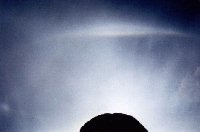
The Altar Platform
Here the author suddenly speaks of an altar, which was never mentioned before. This is due to the change of the upper contact arc with the solar altitude. Properly, one should now speak of the circumscribed halo, as the lower and upper contact arcs can unite at this solar altitude. However, the circumscribed halo was not fully developed, so only the upper part was visible. At about 40°, the upper part of the circumscribed halo is widely extended and the depression directly above the 22° halo has almost disappeared. In this case, the halo acts like a platform standing on the 22° halo, so the impression that it is an altar is understandable. At the foot of the altar (22° halo) are the souls of those who were slaughtered. The color red stands for blood. And this color predominates in the lower part of the circumscribed halo. Therefore, the souls of the slaughtered are the lower part of the circumscribed halo. The altar slab also has a red color, as derived from Rev 8:5. There it says: "Then an angel took fire from the altar and hurled it to the earth". This also supports the assumption that the altar slab is the upper part of the circumscribed halo.
After all seven seals are opened, a dramatic event begins:
"And a great sign appeared in heaven: a woman clothed with the sun, with the moon under her feet, and on her head a crown of twelve stars, and she is pregnant and cries out in labor pains and birth pangs."
"And a great sign appeared in heaven: a woman clothed with the sun, with the moon under her feet, and on her head a crown of twelve stars, and she is pregnant and cries out in labor pains and birth pangs."
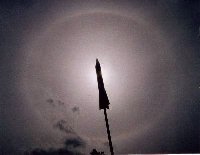
The Pregnant Woman
Now the sun has risen even higher, about 45°, and the circumscribed halo completes itself. This gives the impression of a pregnant woman. Her belly is the still extensive fully circumscribed halo, and her head is the horizontal circle (crown with twelve stars). With the sun rising further, the circumscribed halo slowly approaches the 22° halo. The thinning of the belly is seen by the author as a birth. The red color of the circumscribed halo shows him that the woman is exposed to great birth pains. The proportions of head and belly remain almost the same even with the sun’s elevation increasing, as the horizontal circle also gets a smaller diameter.
"And another sign appears in the sky, and behold; a dragon, great and fiery red, with seven heads and ten horns and with seven diadems on its heads, and its tail sweeps away a third of the stars of the sky and casts them to the earth. And the dragon stands before the woman who is about to give birth, to devour her child as soon as she gives birth."
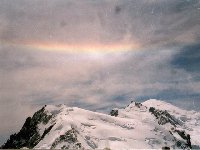
The fiery red dragon
The sun has risen even higher, about 70°. At this solar height, the circumscribed halo is close to the 22° halo. For the author, the birth is almost complete when a dragon appears. Its size and red color suggest the circumhorizontal arc, which lies below the circumscribed halo and, from the author's perspective, will swallow the child falling downwards. Even the size indication, "it sweeps away a third of the stars", is correct, as the circumhorizontal arc spans about a third of the sky.
"And there was a war in heaven: Michael and his angels rose to fight the dragon. And the dragon and his angels took up the fight, but could not prevail, and there was no longer a place for them in heaven. And the great dragon, the ancient serpent, who is called the devil and Satan, who deceives the whole world—he was thrown down to the earth, and his angels were thrown down with him."
The sun has passed its highest point and begins to sink. With it, the circumhorizontal arc also approaches the horizon and "is cast down to the earth".
"When the dragon saw that he was cast down to the earth, he pursued the woman who had given birth to the boy. And the woman was given the two wings of the eagle, so she might fly to her place in the wilderness, where she is nourished for a time and times and half a time, away from the serpent."
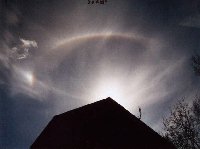
The Wing of the Eagle
The impression that the dragon pursues the woman can be explained by the movement of the sun. With the sun, the circumhorizontal arc also moves, which is very noticeable when it is low on the horizon. The note that the woman gave birth to the boy means that the described halo is no longer present. The color has changed from red to white - only the 22° halo is still visible. However, the woman has gained wings. This refers to the horizontal circle, which is now no longer complete, but only about half visible. This now gives the impression of wings. Previously, the horizontal circle was complete and smaller when the sun's altitude was high, so that it was still thought to be the woman's head.
After the dragon is defeated, two new beings appear:"And I saw a beast rising out of the sea, with ten horns and seven heads, with ten diadems on its horns and blasphemous names on its heads. And the beast that I saw was like a leopard, its feet were like a bear's paws, and its mouth was like a lion's mouth. And the dragon gave it his power and his throne and great authority. One of its heads seemed to have a mortal wound, but its deadly wound was healed."
Then another beast comes along.
"And I saw another beast rising out of the earth, it had two horns like a lamb and spoke like a dragon. It exercises all the authority of the first beast in its presence.(...)And it performs great signs, even making fire come down from heaven to earth in front of people."
"And I saw another beast rising out of the earth, it had two horns like a lamb and spoke like a dragon. It exercises all the authority of the first beast in its presence.(...)And it performs great signs, even making fire come down from heaven to earth in front of people."
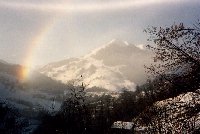
One of the Animals
The two animals resemble the dragon ("it spoke like the dragon"). Both the dragon and the first animal are described with "seven heads and ten horns and with seven diadems". The two new halos must therefore closely resemble the circumhorizontal arc. For this, only the left and right infralateral arc come into consideration at a solar altitude of about 40°. It is easy to imagine that at a distance of just over 40° to the right and left of the sun, an infralateral arc towered. One from the sea, the other from the water. This also suggests that it lets fire fall from the sky to the earth. Red is very conspicuous in an infralateral arc.
"And I saw heaven opened, and behold, a white horse, and the one sitting on it is called Faithful and True, and in righteousness he judges and makes war. His eyes are like a flame of fire, and on his head are many diadems, and he has a name written that no one knows but himself. He is clothed in a robe dipped in blood, and his name is called: The Word of God. And the armies of heaven follow him on white horses, they were clothed in fine white linen. And from his mouth came a sharp sword,..."
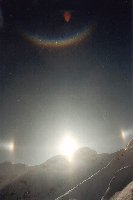
The Diadem on His Head
Now the sun is even lower on the horizon. The sun's height was likely about 25°. As previously mentioned, a light pillar (sword) at this position of the sun is rare, but quite possible. The blood-soaked, i.e., red, garment is the circumzenithal arc, which is approximately 44° away from the sun and primarily red in color. The diadems on its head are actually the circumzenital arc, which lies directly above the supralateral arc. The armies in heaven that follow it could be the 120° parhelia. The white horse on which "he" sits is likely the lower tangent arc. In this case, the parhelia appear as the eyes of the man whose body forms the 22° halo. If one were to see the 22° halo as the white horse, then the parhelia are more the eyes of the horse than those of the man.
"And I saw an angel coming down from heaven, holding the key to the abyss and a heavy chain in his hand. And he seized the dragon, the old serpent, who is the devil and Satan, and bound him for a thousand years and threw him into the abyss, closed it, and set a seal on it,..."
The chain might be the horizontal circle that spread out to the infralateral arc and "bound" it. The fact that the dragon is thrown into the abyss can be explained by the setting sun. With it, the infralateral arc, along with the horizontal circle, sinks to the horizon, thus into the abyss. However, it is not assumed that he saw the "bound infralateral arc" until sunset. Rather, the binding would have begun at an altitude of about 20° of the sun, after which the infralateral arc regressed more and more until finally only a small piece protruded above the horizon.
"And I saw a great throne and the one who sat upon it; the earth and the sky fled from his presence, and there was no place for them."
As at the beginning of the vision, the author sees the throne again. This is the upper contact arc. The solar height was probably around 20°, so that the upper contact arc looks very similar to a throne.
The last image Johannes sees is the new city of Jerusalem:
Then he carried me away in the spirit to a great, high mountain and showed me the holy city of Jerusalem, coming down out of heaven from God, filled with the glory of God. It shone like a precious stone, like a crystal-clear jasper. The city has a great and high wall, with twelve gates and twelve angels on them. (...) The city was laid out as a square, its length as great as its width. (...) Its wall is built of jasper, like pure glass. The foundations of the city wall are adorned with every kind of precious stone. (...) The twelve gates are twelve pearls; each of the gates consists of a single pearl. The street of the city is pure gold, like transparent glass. I saw no temple in the city, for the Lord, their God, the ruler over all creation, is their temple, he and the Lamb. The city needs neither sun nor moon to shine for it. For the glory of God illuminates it, and its lamp is the Lamb. (...) And he showed me a river, the water of life, clear as crystal; it flows from the throne of God and of the Lamb. Between the street of the city and the river, on either side, are trees of life. They bear fruit twelve times, once each month; and the leaves of the trees are for the healing of the nations.
Then he carried me away in the spirit to a great, high mountain and showed me the holy city of Jerusalem, coming down out of heaven from God, filled with the glory of God. It shone like a precious stone, like a crystal-clear jasper. The city has a great and high wall, with twelve gates and twelve angels on them. (...) The city was laid out as a square, its length as great as its width. (...) Its wall is built of jasper, like pure glass. The foundations of the city wall are adorned with every kind of precious stone. (...) The twelve gates are twelve pearls; each of the gates consists of a single pearl. The street of the city is pure gold, like transparent glass. I saw no temple in the city, for the Lord, their God, the ruler over all creation, is their temple, he and the Lamb. The city needs neither sun nor moon to shine for it. For the glory of God illuminates it, and its lamp is the Lamb. (...) And he showed me a river, the water of life, clear as crystal; it flows from the throne of God and of the Lamb. Between the street of the city and the river, on either side, are trees of life. They bear fruit twelve times, once each month; and the leaves of the trees are for the healing of the nations.

The City Wall
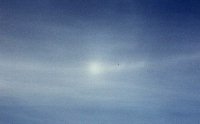
A city gate
At first glance, it may seem impossible to connect the city of Jerusalem described by John with a halo phenomenon. Thus, city walls, foundations, streets, rivers, trees, city gates, the Lamb, and the throne of God must be explained by halos. The key to this image is that John sees the city from a bird's eye view. The city is shown to him from a high mountain. Yet he sees the city descending from heaven. One must imagine it as if John sees a huge city map in the sky.
The city wall is the horizontal circle that John sees completely for the first time at a low sun position. The spread of the horizontal circle had already begun when it extended to the infralateral arc and "bound" him. The complete horizontal circle results in a completely new image in the sky for John, as all previous phenomena occurred on the sun side and near the zenith. Now he sees a "new heaven" because the phenomenon extends to the anti-solar point. The author describes the city wall as being as long as it is wide, which applies to the horizontal circle. The wall is made of jasper, like pure glass. Jasper is a white, transparent stone, and the horizontal circle also has a white color. Previously, the one sitting on the throne (Parry arc) was described with jasper. The comparison with jasper suggests that the horizontal circle had very high brightness. However, the city was square and not circular like the horizontal circle. John refers here to Ezekiel's description of the holy city. According to that, the holy city measures 4500 cubits in all directions, thus being square (Ez 48:30-35). The readers to whom John addressed his letter were familiar with the layout of the holy city from Ezekiel's description. Had John spoken of a circular city wall, it would have contradicted Ezekiel and John's vision would not have been credible to them. Therefore, one should not be too bothered that he describes the horizontal circle as square.
Further, John writes that the city gates are twelve pearls, and each gate consists of only one pearl. On the horizontal circle lie the 120° parhelia, whose appearance corresponds very well with pearls. However, there are only two and not twelve. If you add the anthelion and the Liljequist parhelia, you can come at most to 5 city gates. The number twelve again is based on Ezekiel's model, who also describes the holy city with twelve city gates (Ez, 48 30-34).
The city's outline is thus described by halos. Now it's about the city's interior. John writes that the city has no temple. The city doesn't need a temple because the Lord and the Lamb are its temple. Nor does the city need the sun or moon to shine on it. For the glory of God illuminates it, and its lamp is the Lamb.
This passage confirms the statements made earlier: The Lamb is the combination of the 22° halo (head), parhelia (eyes), and upper tangent arc (horns). The Lord was interpreted above as the Parry arc sitting on the upper tangent arc (throne). Furthermore, the identity of the Lamb's horns and the throne of God is confirmed. The Parry arc and the upper tangent arc lie within the horizontal circle, thus from John's perspective within the city! Furthermore, the upper tangent arc is by far the brightest halo within the horizontal circle in a halo phenomenon primarily produced by column crystals. This makes it clear why John says the city is illuminated by God's glory and its lamp is the Lamb. Moreover, the horn-like appearance gives an indication of the sun's altitude: It should have been just under 20°. In the images he described earlier, the sun was similarly high. They followed each other quite quickly. The large break between the description of the image of the great white throne and the vision of the new Jerusalem is explained by the fact that he sees the horizontal circle completely for the first time at a low sun position, and he, therefore, perceives a new heaven and a new earth. The observation probably took place in the evening, as he sees the city descending from heaven, because with the sun, the horizontal circle also sinks towards the horizon.
What could the river represent? John writes that the river flows from the throne of God and the Lamb and its water is as clear as crystal. The throne is the upper tangent arc. And from this halo, a type of halo does indeed emerge: it is Wegener's anthelic arc. It runs at this sun height from the upper tangent arc to the anthelion, thus through the whole city. Presumably, only one of the two anthelic arcs began directly at the throne. This type of halo is rarely seen, but it fits well with the observation of a bright upper tangent arc, as it is also caused by column crystals. Here John deviates from Ezekiel's depiction of the holy city. In Ezekiel, the river flows from the temple, while in John, it flows from the throne. If one sees a halo phenomenon as the basis of the Revelation of John, this deviation can be explained. Wegener's anthelic arc is white and faint, thus almost transparent. The comparison with crystal is quite appropriate here.
It is more difficult to associate the street and the trees with a halo. This is because John does not give the exact location in the city. The only hint is this passage: Between the street of the city and the river, on both sides, are trees of life (standard translation).
The exact translation from Greek is, however, disputed. Another translation reads:
In the middle between its street and the river, on both sides (of the river) (stands) the tree of life...(Heinz Giesen). Giesen suspects that John imagines the location of the street so that the street runs along the river, and the river is flanked by trees on both sides (p.474).
Both translations have in common that trees also stand between the street and the river. The only question is what the "on both sides" or "here and there" refers to. Trees can be associated with the color green. They also bear fruit. Fruits are also colorful, e.g., apples red and lemons yellow. Therefore, the fruit-bearing trees cannot be a white halo. As a colored halo, the circumzenithal arc and the supralateral arc are considered at a sun height of 20°. Probably both types of halos were visible, as both plate crystals (120° parhelia) and column crystals were present in large numbers (bright upper tangent arc). Of course, these types of halos bear no resemblance to a tree. But John sees the city from a bird's eye view. In this case, it is quite conceivable that he perceives the circumzenithal and supralateral arcs as a row of trees viewed from above with colorful fruits. For these types of halos to be between the river (Wegener's anthelic arc) and the street, only the other part of Wegener's anthelic arc can be considered a street. In this case, the "on both sides" refers to both sides of the city and not to both sides of the river. All the components within the city have thus been identified with halos. Only the foundations of the city wall, adorned with precious stones of all kinds, are missing. In this case, the right and left infralateral arcs, which shine in all spectrum colors, are considered.
The exact translation from Greek is, however, disputed. Another translation reads:
In the middle between its street and the river, on both sides (of the river) (stands) the tree of life...(Heinz Giesen). Giesen suspects that John imagines the location of the street so that the street runs along the river, and the river is flanked by trees on both sides (p.474).
Both translations have in common that trees also stand between the street and the river. The only question is what the "on both sides" or "here and there" refers to. Trees can be associated with the color green. They also bear fruit. Fruits are also colorful, e.g., apples red and lemons yellow. Therefore, the fruit-bearing trees cannot be a white halo. As a colored halo, the circumzenithal arc and the supralateral arc are considered at a sun height of 20°. Probably both types of halos were visible, as both plate crystals (120° parhelia) and column crystals were present in large numbers (bright upper tangent arc). Of course, these types of halos bear no resemblance to a tree. But John sees the city from a bird's eye view. In this case, it is quite conceivable that he perceives the circumzenithal and supralateral arcs as a row of trees viewed from above with colorful fruits. For these types of halos to be between the river (Wegener's anthelic arc) and the street, only the other part of Wegener's anthelic arc can be considered a street. In this case, the "on both sides" refers to both sides of the city and not to both sides of the river. All the components within the city have thus been identified with halos. Only the foundations of the city wall, adorned with precious stones of all kinds, are missing. In this case, the right and left infralateral arcs, which shine in all spectrum colors, are considered.
Summarized by Mark Vornhusen 16.11.1998